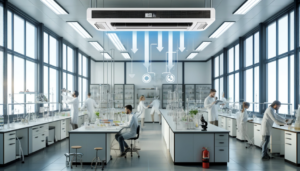
Optimizing Laboratory Safety with Single Flow Air Systems
In the world of scientific research, maintaining a controlled and safe environment within a laboratory is paramount. One crucial aspect of laboratory infrastructure that ensures this environment is the air handling system. Specifically, the implementation of a single flow air system plays a critical role in maintaining air quality, ensuring safety, and enhancing the overall efficiency of laboratory operations. This blog post will delve into the importance of single flow air systems in laboratory infrastructure, highlighting their benefits and why they are essential for modern laboratories.
What is a Single Flow Air System?
A single flow air system, also known as a single pass air system, involves the continuous introduction of fresh air into a laboratory space while simultaneously expelling used air out of the space. Unlike recirculating systems, which reuse a portion of the air, single flow systems ensure that the air within the laboratory is always fresh and uncontaminated. This system is particularly beneficial in environments where contamination control and air quality are critical.
Key Benefits of Single Flow Air Systems
1. Enhanced Contamination Control
In laboratories where hazardous chemicals, biological agents, or radioactive materials are handled, controlling contamination is crucial. Single flow air systems minimize the risk of cross-contamination by ensuring that any airborne contaminants are swiftly removed from the laboratory environment. This continuous removal and replacement of air help maintain a sterile and safe workspace, essential for accurate scientific experimentation and research.
2. Improved Air Quality
Maintaining high air quality is vital for both the safety of laboratory personnel and the integrity of experimental results. Single flow air systems ensure that laboratory air is consistently fresh and free from contaminants. This reduces the likelihood of exposure to harmful substances and helps prevent the build-up of noxious fumes or particulates, thereby safeguarding the health of laboratory workers.
3. Regulatory Compliance
Many laboratories are subject to stringent regulatory requirements regarding air quality and contamination control. Single flow air systems help laboratories meet these regulatory standards by providing a reliable means of maintaining controlled and clean air environments. Compliance with these regulations not only ensures the safety of laboratory personnel but also enhances the credibility and reliability of the laboratory’s work.
4. Temperature and Humidity Control
Single flow air systems can be integrated with heating, ventilation, and air conditioning (HVAC) systems to provide precise control over temperature and humidity levels within the laboratory. This is particularly important for experiments that are sensitive to environmental conditions. By maintaining optimal temperature and humidity, these systems contribute to the reproducibility and accuracy of experimental results.
5. Energy Efficiency and Cost Savings
Although single flow air systems may initially seem energy-intensive due to the continuous influx and expulsion of air, advancements in technology have made them more energy-efficient. Modern single flow systems are designed to minimize energy consumption while maximizing air quality control. Additionally, the prevention of contamination-related incidents and the reduction in the need for costly decontamination procedures can lead to significant cost savings in the long run.
Implementing Single Flow Air Systems in Your Laboratory
When considering the implementation of a single flow air system, it is essential to conduct a thorough assessment of your laboratory’s specific needs and requirements. Consulting with experts in laboratory design and HVAC systems can help ensure that the chosen air handling system is tailored to your laboratory’s unique operational demands. Additionally, regular maintenance and monitoring are crucial to ensure the system’s ongoing effectiveness and efficiency.
Conclusion
In conclusion, single flow air systems are an integral component of modern laboratory infrastructure. They provide enhanced contamination control, improved air quality, regulatory compliance, precise environmental control, and potential cost savings. By investing in a single flow air system, laboratories can create a safer, more efficient, and more reliable environment for scientific research and experimentation. As the demands on laboratories continue to evolve, the importance of robust air handling systems will only grow, making single flow air systems a cornerstone of laboratory safety and productivity.
 Niti Vanee, PhD
Niti Vanee, PhD
CEO – iGenomeDX
Managing Partner – Alamo Biocenter

